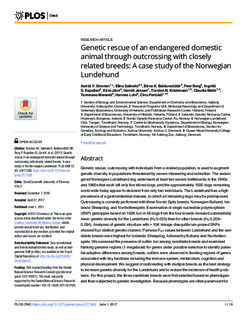| dc.contributor.author | Stronen, Astrid Vik | |
| dc.contributor.author | Salmela, Elina | |
| dc.contributor.author | Baldursdottir, Birna K. | |
| dc.contributor.author | Berg, Peer | |
| dc.contributor.author | Espelien, Ingvild S. | |
| dc.contributor.author | Jarvi, Kirsi | |
| dc.contributor.author | Jensen, Henrik | |
| dc.contributor.author | Kristensen, Torsten N. | |
| dc.contributor.author | Melis, Claudia | |
| dc.contributor.author | Manenti, Tommaso | |
| dc.contributor.author | Lohi, Hannes | |
| dc.contributor.author | Pertoldi, Cino | |
| dc.date.accessioned | 2017-10-30T13:57:43Z | |
| dc.date.available | 2017-10-30T13:57:43Z | |
| dc.date.created | 2017-06-08T09:53:50Z | |
| dc.date.issued | 2017 | |
| dc.identifier.citation | PLoS ONE. 2017, 12 (6), 1-18. | nb_NO |
| dc.identifier.issn | 1932-6203 | |
| dc.identifier.uri | http://hdl.handle.net/11250/2462929 | |
| dc.description.abstract | Genetic rescue, outcrossing with individuals from a related population, is used to augment genetic diversity in populations threatened by severe inbreeding and extinction. The endangered Norwegian Lundehund dog underwent at least two severe bottlenecks in the 1940s and 1960s that each left only five inbred dogs, and the approximately 1500 dogs remaining world-wide today appear to descend from only two individuals. The Lundehund has a high prevalence of a gastrointestinal disease, to which all remaining dogs may be predisposed. Outcrossing is currently performed with three Nordic Spitz breeds: Norwegian Buhund, Icelandic Sheepdog, and Norrbottenspets. Examination of single nucleotide polymorphism (SNP) genotypes based on 165K loci in 48 dogs from the four breeds revealed substantially lower genetic diversity for the Lundehund (HE 0.035) than for other breeds (HE 0.209–0.284). Analyses of genetic structure with > 15K linkage disequilibrium-pruned SNPs showed four distinct genetic clusters. Pairwise FST values between Lundehund and the candidate breeds were highest for Icelandic Sheepdog, followed by Buhund and Norrbottenspets. We assessed the presence of outlier loci among candidate breeds and examined flanking genome regions (1 megabase) for genes under possible selection to identify potential adaptive differences among breeds; outliers were observed in flanking regions of genes associated with key functions including the immune system, metabolism, cognition and physical development. We suggest crossbreeding with multiple breeds as the best strategy to increase genetic diversity for the Lundehund and to reduce the incidence of health problems. For this project, the three candidate breeds were first selected based on phenotypes and then subjected to genetic investigation. Because phenotypes are often paramount for domestic breed owners, such a strategy could provide a helpful approach for genetic rescue and restoration of other domestic populations at risk, by ensuring the involvement of owners, breeders and managers at the start of the project. | nb_NO |
| dc.language.iso | eng | nb_NO |
| dc.publisher | Public Library of Science | nb_NO |
| dc.rights | Navngivelse 4.0 Internasjonal | * |
| dc.rights.uri | http://creativecommons.org/licenses/by/4.0/deed.no | * |
| dc.title | Genetic rescue of an endangered domestic animal through outcrossing with closely related breeds: A case study of the Norwegian Lundehund | nb_NO |
| dc.type | Journal article | nb_NO |
| dc.type | Peer reviewed | nb_NO |
| dc.description.version | publishedVersion | nb_NO |
| dc.source.pagenumber | 1-18 | nb_NO |
| dc.source.volume | 12 | nb_NO |
| dc.source.journal | PLoS ONE | nb_NO |
| dc.source.issue | 6 | nb_NO |
| dc.identifier.doi | 10.1371/journal.pone.0177429 | |
| dc.identifier.cristin | 1474649 | |
| dc.description.localcode | © 2017 Stronen et al. This is an open access article distributed under the terms of the Creative Commons Attribution License, which permits unrestricted use, distribution, and reproduction in any medium, provided the original author and source are credited. | nb_NO |
| cristin.unitcode | 194,66,10,0 | |
| cristin.unitname | Institutt for biologi | |
| cristin.ispublished | true | |
| cristin.fulltext | original | |
| cristin.qualitycode | 1 | |

